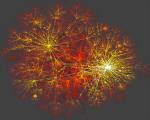complex systems group
official web page
Site menu:
Research Topics
It's funny. One day you begin your PhD with (in principle) a well defined topic of study. You think that in some years you'll be an expert on that very specific subject... Some years later you realize that you are not the expert that you were suposed to be... Our excuse: We found so many interesting things during our way that we couldn't pay attention to just one of them!! Here you will find a brief description of the group research interests... (Currently this page is under construction)

Neuroscience
One of the most challenging horizons in science is to understand how the human brain behaves, that is, how, from a network of many millions of individual neurons processing signals, a consciousness life, intellegence, dreams and memory, emerge. Current observation techniques (EEG & MEG and calcium imaging) confirm the existence of background rhythms corresponding to synchronous activation of neurons. Using in-silico and in-vitro models of neuronal networks we modestly aim to contribute into the understanding of the role of the wiring architecture in the observed activity patterns.

Complex Networks
Despite the enormous differences among an electric circuit, Internet, a brain or the DNA, it turns out that all these systems can be analyzed from the viewpoint of the Complex Networks Theory. The main characteristic of this approach is the belief that the properties found in a system cannot be derived from its features at a lower level of description but considering all the interactions between its elements as a whole. For instance, however much we understand the dynamics of a single neuron, it is not enough to understand the emergent properties that our brain exhibits, such as memory or language. It is required to study how the neurons globally link each other.

Synchronization of Dynamical Systems
Chrystiaan Huygens was (probably) the first scientist that fell in love with the phenomenon of synchronization. He was trying to design a fully reliable pendulum clock when he realized that two weakly coupled pendulums were able to synchronize their dynamics. Since then, synchronization has been reported in many physical, chemical, biological or electronic systems. Somehow it is everywhere. In the Complex Systems Group were are specially interested in the synchronization of oscillators, excitable systems (e.g., neurons), lasers and complex networks.

Laser Dynamics
From its creation in 1960, the laser has found an interminable list of applications in every possible field of technology, science and industry. However, the laser itself is also a fascinating study subject, since its apparent stability hides a rich nonlinear dynamics where chaos, turbulence, pattern formation, synchronization and many other phenomena can be experimentally observed and theoretically studied. Our group is interested in fast solid-state laser dynamics, noise effects, polarization dynamics and optic turbulence in high power lasers.

Social Sciences
Social phenomena are sometimes exasperating when they are treated with tools coming from statistichal physics. In this case, the dynamical systems are people, and you can imagine how difficult it is to model a person with a bunch of equations. Counterintuitively, it is more straightforward to model how a group of people behaves rather than a single person. From this perspective, we study phenomena such as grouping evolution (not necessary people, animals are also welcome!), traffic dynamics or social interactions (e.g., colaboration networks, recommendation networks, etc...).